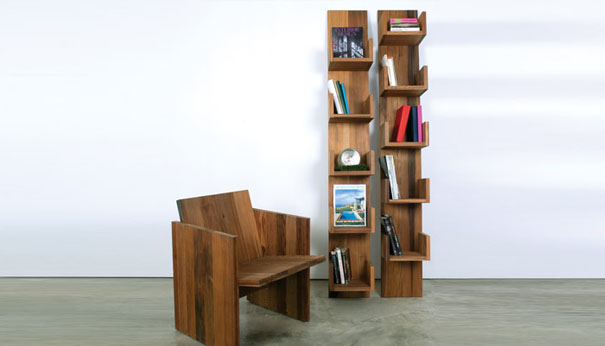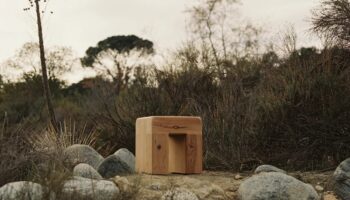Deger Cengiz’s Leaning Shelves
Deger Cengiz’s Leaning Shelves for Voos nicely illustrate three of my favorite principles of sustainable design: 1. no felled trees, 2. no fasteners, 3. easy installation. The three concepts are particularly relevant when it comes to shelving (a pastime that evokes one of my personal pet peeves–the maddeningly hidden five inch screw sunk deep into a wall stud). No tricks of that sort for Cengiz.
His shelves are sourced from a long-lived artifact (a water tower in New York); assembled with bare ingenuity, old school joinery, and just a bit of glue; and installed with the help of gravity and the slightest of upright angles. All of that is green to be sure, and they look good, too: the reclaimed redwood has been milled and finished and joined into a product that appears gloriously new, with complementarily-oriented wood grains to boot.
Leaning Shelves. Designed by Deger Cengiz for Voos.

Planar Chair and Leaning Shelves. Designed by Deger Cengiz for Voos.

Leaning Shelves. Designed by Deger Cengiz for Voos.
Cengiz’s version of the leaning shelf is in good company. The past year alone has seen incarnations that might be characterized as European (Milica Nesovanovic’s Pisa Tower), industrial (Swedese’s Portable Bookshelf); and apocalyptic (Victor Barish’s Disaster Bookshelf). In this company, Cengiz emerges as a bit of a purist. His design is simple, natural, and smart, not to mention uniquely American.
This last quality is owed to a burgeoning practice among U.S. designers–incorporating a regional artifact as the centerpiece or principal material. We’ve seen this recently with the pickle barrels of Douglas Thayer’s Handcrafted Benches and the Coney Island Boardwalk remants of Uhuru’s Cyclone Lounger. Like the great tradition of coopersmiths and railroad workers (and the distinctive aesthetic of the artifacts they’ve left us), wooden water towers and the brave souls who built them are a quintessentially American phenomena. Though largely defunct, they yet provide a striking aesthetic statement across the landscape–from Eugene, Oregon to NYC; Yuma, Arizona to Ybor City, FL. If they must be knocked down, it’s gratifying that there are creative minds like Cengiz to find a functional and fashionable use for what’s left.
Via Inhabitat.




Leave a Reply